Geography
The Kingdom of Cambodia, formerly Kampuchea, is a Southeast Asian nation that borders Thailand, Laos, Vietnam, and the Gulf of Thailand. The capital city is Phnom Penh.
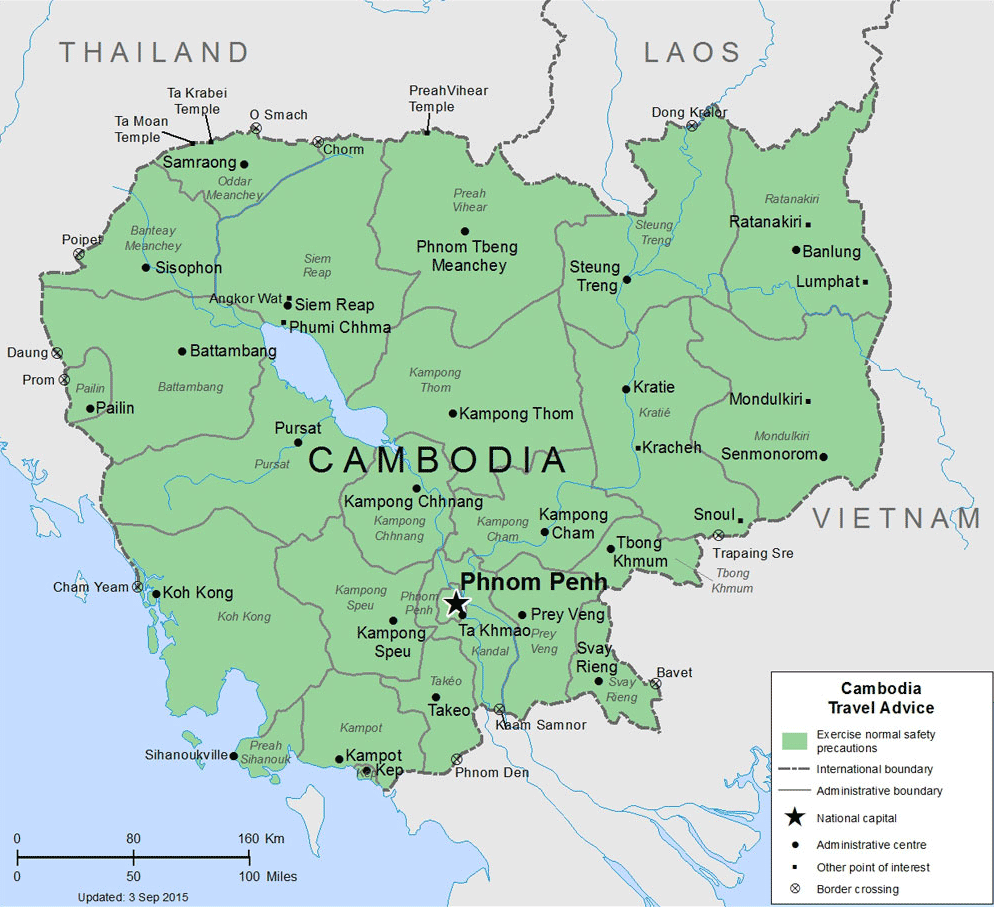
Situated in the southwest of the Indochinese peninsula, Cambodia occupies a total area of 181,035 square kilometers and borders Thailand to the west and northwest, Laos to the northeast, Vietnam to the east, and Gulf of Thailand to the southwest. Cambodia’s geographic coordinates are 13 00 N, 105 00 E. Cambodia’s terrain consists mainly of low plains, with mountains to the southwest and north. Two dominant physical features of Cambodia are the Mekong river, which runs from north to south of the country, and the Tonlé Sap Lake. Natural resources include oil and gas, timber, gemstones, iron ore, manganese, phosphates, hydropower potential.
Religion
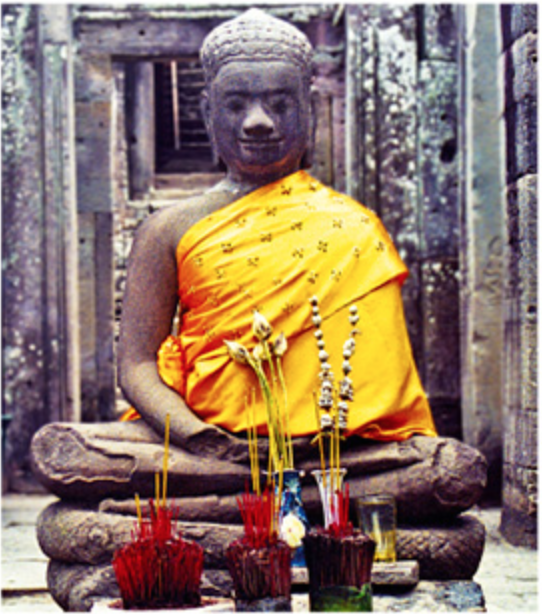
Theravada Buddhism is the prevailing official religion in Cambodia and approximately ninety percent of the population is Buddhist. Islam, Hinduism and Christianity are also embraced in Cambodia.
Since Buddha statues and images represent the revered Buddha, visitors are asked to treat all such statues and images with respect, so as not to offend local people.
In Cambodia, regardless of religion, the country maintains a harmonised state.
Public holiday
The Kingdom of Cambodia has a great wealth of traditional and cultural festivals dated according to the Cambodian lunar calendar. All of these festivals are influenced by the concepts of Buddhism, Hinduism, and royal cultures. Most of these are great rejoicings of the urban and rural populace, held annually as follows.
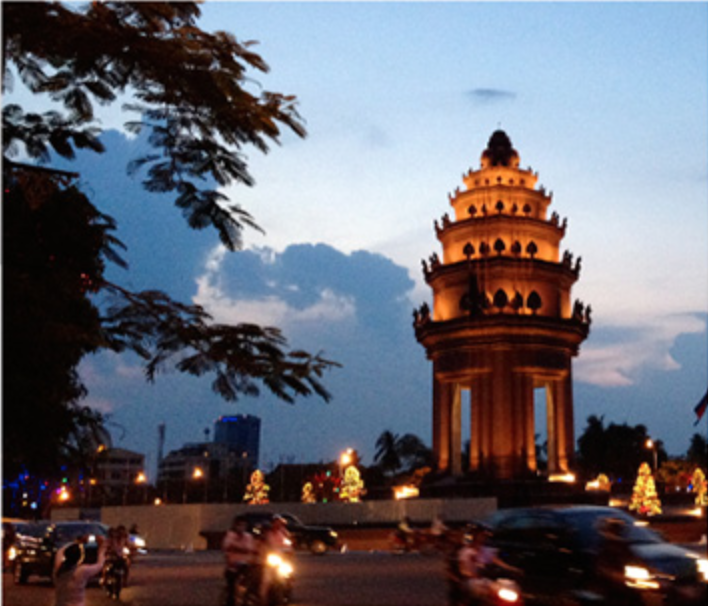
International New Year’s Day
On the eve of International New Year’s Day, the Ministry of Tourism will host the Countdown Day in front of the NagaWorld Hotel in Phnom Penh. This festival will be attended by officials from all public and private sectors to celebrate International New Year’s Day.
Monday, January 01, 2024
Victory Day over the Genocidal Regime
The Victory Day commemorates the end of the Pol Pot Genocidal Regime. This important ceremony is marked by a military parade, carnival floats, and national achievements. All over the city, flags and bunting as a sign of national pride adorn the front of shops and houses in all the main thoroughfares.
Sunday, January 07, 2024
International Women’s Day
International Women’s Day is a global day celebrating the economic, political, and social achievements of women and marking respect, appreciation, and love towards women.
Friday, March 08, 2024
Cambodian New Year’s Day
The Khmer New Year Day, called “Bon Chol Chhnam Thmei Khmer” in the Khmer language, is celebrated on 13 April in keeping with the Cambodian lunar calendar. The New Year holidays last for three days. This festival marks the end of the harvest season when Cambodian farmers enjoy the fruits of their labor and relax before the start of the rainy season.
Sunday, April 14, 2024
Monday, April 15, 2024
Tuesday, April 16, 2024
Visakh Bochea Day, or “Buddha’s Birth Commemoration Ceremony”
The Visakh Bochea Day, called “Bon Visakh Bochea” in the Khmer language, commemorates the anniversary of the birth and illumination of the Buddha.
Wednesday, May 22, 2024
Royal Ploughing Ceremony
The Royal Ploughing Ceremony, called “Bon Chroat Preah Nongkoal” in the Khmer language, is solemnly celebrated at the beginning of the sowing and planting season. Every year, in May, this cultural ceremony takes place at Meru Field in front of the National Museum (next to the Royal Palace).
Sunday, May 26, 2024
International Labor Day
International Labor Day is an annual holiday to celebrate the economic and social achievements of workers. Labor Day has its origins in the labor union movement, specifically the eight-hour day movement, which advocated eight hours for work, eight hours for recreation, and eight hours for rest.
Wednesday, May 01, 2024
Royal Birthday of His Majesty Preah Bat Samdech Preah Baromneath Norodom Sihamoni, the King of the Kingdom of Cambodia
This celebration is triumphantly held inside the Royal Palace and fireworks are prominently displayed on Tonlé Sap on 14 May to revere King Norodom Sihamoni, the son of His Majesty Preah Bat Samdech Preah Norodom Sihanouk, Preahmahaviraksat. He was born on 14 May 1953 in Phnom Penh Capital.
Thursday, May 14, 2024
Royal Birthday of Samdech Preah Maha Ksatrei Norodom Monineath Sihanouk, Cambodian Queen-Mother with Freedom, Dignity and Happiness
Tuesday, June 18, 2024
Constitution Day
The Constitution Day marks the proclamation of the constitution of the Kingdom of Cambodia issued on 24 September 1993.
Tuesday, September 24, 2024
Phchum Ben Day, or “Spirit Commemoration Ceremony”
On 15 October, the Spirit Commemoration Ceremony, called “Bon Phchum Ben” in the Khmer language, is one of the most significant cultural and religious events of the year jointly celebrated for the spirits of the dead including ancestors and relatives.
Tuesday, October 01, 2024
Wednesday, October 02, 2024
Thursday, October 03, 2024
Commemoration Day to the Royal Soul of His Majesty Preah Bat Samdech Preah Norodom Sihanouk, Preahmahaviraksat, King-Father of the Cambodian National Independence, Territorial Integrity and Unity
This celebration is triumphantly held inside the Royal Palace and at royal governmental institutions on 15 October every year to revere His Majesty King-Father Norodom Sihanouk, or His Majesty Preah Barom Ratanakaodh as his posthumous name, a former influential king of Cambodia. He was born in Phnom Penh Capital, Cambodia, on 31 October 1922, and he died in Beijing Capital, the People’s Republic of China, on 15 October 2012.
Tuesday, October 15, 2024
Royal Coronation of His Majesty Preah Bat Samdech Preah Baromneath Norodom Sihamoni, the King of the Kingdom of Cambodia
Tuesday, October 29, 2024
Independence Day
The National Independence Day takes place at the site of the Independence Monument at the junction of Preah Norodom Blvd. and Preah Sihanouk Blvd. to commemorate the independence Cambodia gained from France on 9 November 1953. This important ceremony is marked by a military parade, carnival floats, and national achievements. All over the city, flags and bunting as a sign of national pride adorn the front of shops and houses in all the main thoroughfares.
Saturday, November 09, 2024
Regatta, Procession of Illuminated Floats, Salutation to the Moon, and Offering of Bananas and Ambok
The festivities are held in front of the Royal Palace, marking a change in the flow of Tonlé Sap, the fishing and ebbing-water season, and thanksgiving to the Mekong River for providing the country with fertile land and abundant fish. Moreover, the boat racing marks the strength of the powerful Khmer marine forces in the ancient Khmer Empire. Provincial residents always save up to visit the capital to join in the festivities.
Thursday, November 14, 2024
Friday, November 15, 2024
Saturday, November 16, 2024
Flag

The flag of Cambodia symbolizes the country’s slogan: Nation, Religion, King. The two large blue stripes represent royalty and the center red stripe represents the nation. The image of the white temple stands for the nation’s religion.
History
The race that produced the builders of Angkor developed slowly through the fusion of the Mon-Khmer racial groups of Southern Indochina during the first six centuries of the Christian era. Under Indian influence, two principal centers of civilization developed. The older, in the extreme south of the peninsula was called “Funan” (the name is a Chinese transliteration of the ancient Khmer form of the word “Phnom”, which means “hill”). Funan was a powerful maritime empire that ruled over all the shores of the Gulf of Siam. In the mid-sixth century, the Kambuja who lived in the middle Mekong (north of present day Cambodia), broke away from Funan. Within a short period, this new power known as Chenla, absorbed the Funanese Kingdom. In the late seventh century, Chenla broke into two parts: Land Chenla (to the north) and Water Chenla (to the south along the Gulf of Thailand) dominated by the Chinese. Land Chenla was fairly stable during the 8th century, whereas Water Chenla was beset by dynastic rivalries. During this period, Java invaded and took control part of the country.
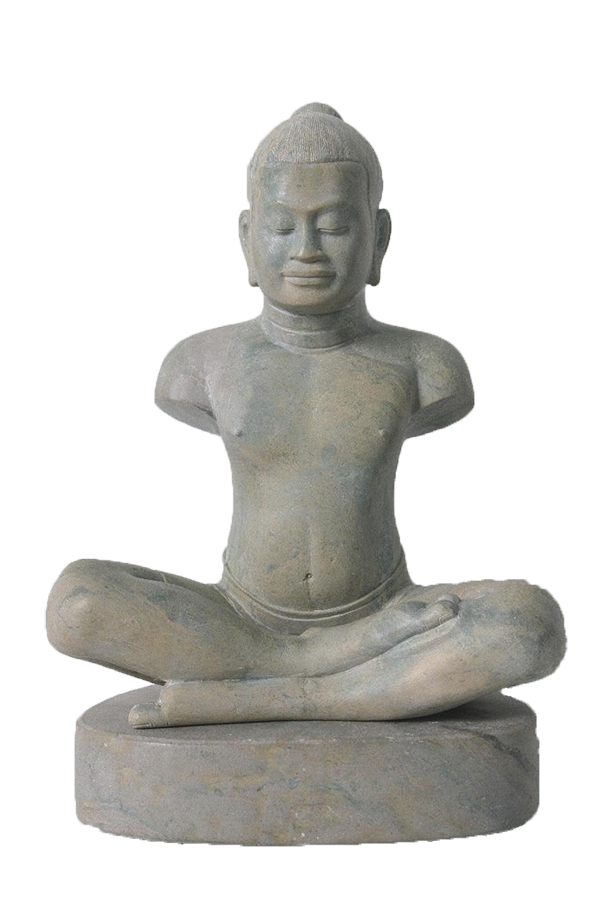
At the beginning of the ninth century, the kings set up their respective capital in the present province of Siem Reap. For nearly six centuries, the kings enriched it by building temples one after another and each being more sumptuous than the other. Two hundred of these temples are spread all over in the Angkorian area some 400 square kilometers in the Siem Reap Province. The temples and their sanctuaries are best known for their architecture and sculptures.
The first founder of Angkor was King Jayayarman II (802-850), who built one of his residences on the plateau of the Kulen in 802. King Indravarman I (887-889), a nephew of King Jayavarman II, constructed a vast irrigation system at Lolei and then built the tower of Preah Ko in 879 and Bakong in 881. King Yasovarman (889-900), the son of King Indravarman I, dedicated the towers of Lolei to his memory in 893 and founded a new capital to the northwest which was to remain the very heart of Angkor. He built the Eastern Baray, a 7km X 2km size artificial lake also.
King Harshavarman I (900-923), the son of King Yasovarman, who took to the foot of Phnom Bakheng, consecrated the little temple of Baksei Chamkrong, and built Prasat Kravan in 921. King Jayavarman IV (928-941), uncle of King Harshavarman I, reigned in northeastern Cambodia near the present town of Koh Ker. He erected several majestic monuments. King Rajendravarman (944-968) returned to Angkor in 952 and built the Eastern Mebon and Prè Roup in 961. In 967, the Brahman Yajnavaraha, a high religious dignitary of royal blood, erected the temple of Banteay Srei, about 20 km northeast of the capital. King Jayavarman V (968-1001) founded a new capital around Takeo Temple.
In the eleventh century, King Suryavarman I (1002-1050) seized Angkor and founded a glorious dynasty. It was at this time that the Gopura of the Royal Palace of Angkor Thom was completed with the sober pyramid of the Phimeanakas at its center. He also erected the temple of Phnom Chiso, some parts of Preah Vihear, and Preah Khan in Kampong Svay District.
King Udayadityavarman II (1050-1066), son of king Suryavarman I, built the mountain temple of Baphuon and Western Baray. King Udayadityavarman’s brother, King Harshavarman III, succeeded him and ruled from 1066 to 1080 when violent strife led to the fall of the dynasty. King Jayavarman VI (1080-1113) continued to build Preah Vihear Mount in Vat Po and Phimai.
King Suryavarman II (1113-1150) extended his power from the coast of the China Sea to the Indian Ocean and built the temples of Angkor Wat, Thommanon, Chau Say Tevoda, Preah Palilay, Preah Pithu and Banteay Samrè. After these dazzling achievements, the Khmer civilization began to decline due to internal strife and an attack by the Chams.
King Jayavarman VII (1181-1220) was the most fascinating personality in Khmer history. He re-established his rule over all of southern Indochina and is best known for his huge building program. He built Ta Prohm (1186) and Preah Khan (1191) as a dedication to his parents.Then he erected Banteay Kdei, Srah Srang, the Terrace of the Leper King, the Terrace of the Elephants, Neak Pean, Ta Saom, Ta Nei, and a few monuments in other parts of the country.t was he who founded his great capital, Angkor Thom and in the center of which, he built the Bayon temple with its two hundred stone faces.
It is understandable that the country was exhausted after these enormous efforts. The decline of the Angkor era began after the death of King Jayavarman VII in the early thirteenth century. Due to Siamese invasion and the limitations of the irrigation system, Khmer power declined so drastically that the king was finally obliged to move to the vicinity of Phnom Penh in 1431. Then, resulting from a series of Siamese and Cham invasions, the country was placed as a French protectorate in 1863.
After regaining Independence in 1953, the country resumed several names:
1. The Kingdom of Cambodia (under the Reachia Niyum Regime from 1953 to 1970)
2. The Khmer Republic (under the Lon Nol Regime from 1970 to 1975)
3. Democratic Kampuchea (under the Pol Pot Genocidal Regime from 1975 to 1979)
4. The People’s Republic of Kampuchea (1979-1989)
5. The State of Cambodia (1989-1993)
6. The Kingdom of Cambodia (1993 until now).
Food
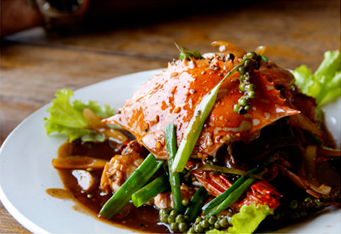
Cambodian cuisine includes noodles, soups, grills, stir-fried, curries, salads, desserts, lots of vegetables, tropical fruits, and of course rice which is the staple food for Cambodians. Cambodian culinary secrets are rarely written down; the recipes were instead handed down from mother to daughter. From an ancient origin has come a traditional cuisine of unsuspected treasures: a unique blend of flavors and colors that enhance the natural ingredients used.
Cambodians perfected the art of blending spice paste using many ingredients like cloves, cinnamon, star anise, nutmeg, cardamom, ginger and turmeric. They add other native ingredients like galangal, garlic, shallots, lemongrass, cilantro, and kaffir lime leaves to these spices to make a rather distinctive and complex spice blend known as “kroeung”.
Although noodles are also popular, almost every meal includes a bowl of rice. A wide range of curries, soups and stir fried are usually served with rice. Being in a country that produces many rice varieties, tourists can enjoy the best aromatic grains and various types of glutinous rice. The latter is more commonly served with a salad or in desserts with fruits.
There are two other unique ingredients that give Cambodian cuisines their fabulous typical flavour. One is a pungent fermented fish paste known as pra-hok and the other, the kapi, a fermented prawn paste. These require an acquired taste for most but they are beloved by some who used them in many dishes or even taken as a dipping sauce. Collectively, these ingredients have become an important aromatic combination commonly used in Cambodian cuisines.
Typically, a Cambodian meal is served with rice and at least three other dishes. It usually includes a soup (samlor), served alongside the main dishes. Each of the individual dishes will either be sweet, sour, salty or bitter; these exist side by side in harmony, sometimes even within a single dish, to offer an original melody. Chili is usually left up to the individual to add. In this way tourists are subtly ensured that they get a bit of every flavour to satisfy their palates.
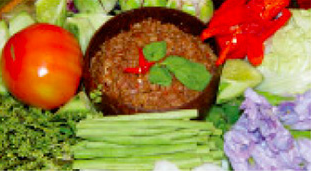
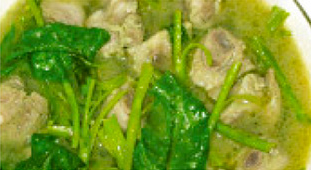
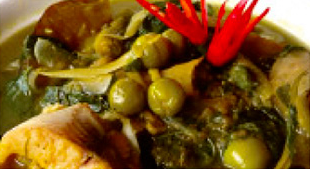
PRAHOK KTIES
Prahok Kties is a delicious staple dish of Cambodian cuisine. Prahok, which means fermented fish, is GOLD to Cambodian cuisine, and can take up different shapes of flavor, depending on the recipe. Prahok Kties is fried with pork taken from the belly sides of the hog, which accentuates the flavor, particularly with the amazing quality of pork (sakchru) that Cambodia produces. It leaves you with an amazing taste in your palates.
MACHU KROUNG
Machu Kroung (soup), a healthy, fulfilling, flavorful sweet and sour soup that is incredibly wholesome. The fried peanuts accentuate the soup. The lemongrass (slak krai) and the saffron truly complement each other and to top it off, the decorative local grown chili flakes (matey) make this quite an appealing site to the eye. This is in fact more towards a curry than it is the soup that most foreigners thought it to be.
KORKO
Korko, the hearty traditional gravy is truly quite delightful; its base ingredient is actually toasted rice pounded and turned into a tasty base and complimented by prahok, pork and pumpkin, which together add a delicious warmth and texture to the palate. Korko, is one of those great fusions of traditional ingredients cooked to perfection.
Travel Advisory
DOs and DON’Ts in Cambodia
People in Cambodia are well-known for their hospitality and warmth. Out of respect, visitors to the Kingdom should take care to observe local customs and practices. You may find it useful to familiarize yourself with the following common dos and don’ts before embarking on your trip to Cambodia.

DOs in Cambodia
> Ask for permission before taking photographs of any Cambodian people or monks.
> It is customary to remove your shoes when entering a place of worship such as a pagoda or temple. Additionally, visitors should dress appropriately when inside a religious site (upper arms and legs should be covered, hats removed).
> It is respectful to remove your shoes when entering someone’s home.
> Though not always expected, a respectful way of greeting another individual is to bow the head slightly with hands pressed together at the chest (known as “Sampeah”).
> If invited to dine in a Cambodian family’s home, it is polite to bring a small gift for the host such as fruit, dessert, or flowers.
> If invited to attend a Cambodian wedding, it is customary to bring cash as a wedding gift.
> When using a toothpick at the table, use one hand to cover your mouth.
> Keep business cards ready, and present them with both hands. Accept business cards with both hands.
DON’Ts in Cambodia
> Don’t use your feet to point at someone.
> Don’t touch a Cambodian person on the head.
> Don’t begin eating if you are a guest at a dinner and the host has yet to take a bite.
> Women should never touch male monks or hand something directly to them.
> Keep public displays of affection to a respectful minimum.
Commonsense Practices
Do not litter; keep our community clean and safe
Plastic bags can be hazardous; dispose them properly
Geography
The Kingdom of Cambodia, formerly Kampuchea, is a Southeast Asian nation that borders Thailand, Laos, Vietnam, and the Gulf of Thailand. The capital city is Phnom Penh.

Situated in the southwest of the Indochinese peninsula, Cambodia occupies a total area of 181,035 square kilometers and borders Thailand to the west and northwest, Laos to the northeast, Vietnam to the east, and Gulf of Thailand to the southwest. Cambodia’s geographic coordinates are 13 00 N, 105 00 E. Cambodia’s terrain consists mainly of low plains, with mountains to the southwest and north. Two dominant physical features of Cambodia are the Mekong river, which runs from north to south of the country, and the Tonlé Sap Lake. Natural resources include oil and gas, timber, gemstones, iron ore, manganese, phosphates, hydropower potential.
Religion

Theravada Buddhism is the prevailing official religion in Cambodia and approximately ninety percent of the population is Buddhist. Islam, Hinduism and Christianity are also embraced in Cambodia.
Since Buddha statues and images represent the revered Buddha, visitors are asked to treat all such statues and images with respect, so as not to offend local people.
In Cambodia, regardless of religion, the country maintains a harmonised state.
ថ្ងៃឈប់សម្រាក
ព្រះរាជាណាចក្រកម្ពុជាសម្បូរទៅដោយពិធីបុណ្យវប្បធម៌ និងប្រពៃណីកំណត់ទៅតាមប្រតិទិនចន្ទគតិរបស់ខ្មែរ។ ពិធីបុណ្យទាំងអស់នេះត្រូវបានជះឥទ្ធិពលដោយព្រះពុទ្ធសាសនា ព្រហ្មញ្ញសាសនា និងព្រះមហាក្សត្រផងដែរ។ ទាំងនេះ ភាគច្រើនជាថ្ងៃដែលផ្តល់នូវភាពសប្បាយរីករាយដល់ប្រជាជនទាំងនៅទីក្រុង និងជនបទ ប្រារព្វធ្វើឡើងជារៀងរាល់ឆ្នាំ។

International New Year’s Day
On the eve of International New Year’s Day, the Ministry of Tourism will host the Countdown Day in front of the NagaWorld Hotel in Phnom Penh. This festival will be attended by officials from all public and private sectors to celebrate International New Year’s Day.
Monday, January 01, 2024
Victory Day over the Genocidal Regime
The Victory Day commemorates the end of the Pol Pot Genocidal Regime. This important ceremony is marked by a military parade, carnival floats, and national achievements. All over the city, flags and bunting as a sign of national pride adorn the front of shops and houses in all the main thoroughfares.
Sunday, January 07, 2024
International Women’s Day
International Women’s Day is a global day celebrating the economic, political, and social achievements of women and marking respect, appreciation, and love towards women.
Friday, March 08, 2024
Cambodian New Year’s Day
The Khmer New Year Day, called “Bon Chol Chhnam Thmei Khmer” in the Khmer language, is celebrated on 13 April in keeping with the Cambodian lunar calendar. The New Year holidays last for three days. This festival marks the end of the harvest season when Cambodian farmers enjoy the fruits of their labor and relax before the start of the rainy season.
Sunday, April 14, 2024
Monday, April 15, 2024
Tuesday, April 16, 2024
Visakh Bochea Day, or “Buddha’s Birth Commemoration Ceremony”
The Visakh Bochea Day, called “Bon Visakh Bochea” in the Khmer language, commemorates the anniversary of the birth and illumination of the Buddha.
Wednesday, May 22, 2024
Royal Ploughing Ceremony
The Royal Ploughing Ceremony, called “Bon Chroat Preah Nongkoal” in the Khmer language, is solemnly celebrated at the beginning of the sowing and planting season. Every year, in May, this cultural ceremony takes place at Meru Field in front of the National Museum (next to the Royal Palace).
Sunday, May 26, 2024
International Labor Day
International Labor Day is an annual holiday to celebrate the economic and social achievements of workers. Labor Day has its origins in the labor union movement, specifically the eight-hour day movement, which advocated eight hours for work, eight hours for recreation, and eight hours for rest.
Wednesday, May 01, 2024
Royal Birthday of His Majesty Preah Bat Samdech Preah Baromneath Norodom Sihamoni, the King of the Kingdom of Cambodia
This celebration is triumphantly held inside the Royal Palace and fireworks are prominently displayed on Tonlé Sap on 14 May to revere King Norodom Sihamoni, the son of His Majesty Preah Bat Samdech Preah Norodom Sihanouk, Preahmahaviraksat. He was born on 14 May 1953 in Phnom Penh Capital.
Thursday, May 14, 2024
Royal Birthday of Samdech Preah Maha Ksatrei Norodom Monineath Sihanouk, Cambodian Queen-Mother with Freedom, Dignity and Happiness
Tuesday, June 18, 2024
Constitution Day
The Constitution Day marks the proclamation of the constitution of the Kingdom of Cambodia issued on 24 September 1993.
Tuesday, September 24, 2024
Phchum Ben Day, or “Spirit Commemoration Ceremony”
On 15 October, the Spirit Commemoration Ceremony, called “Bon Phchum Ben” in the Khmer language, is one of the most significant cultural and religious events of the year jointly celebrated for the spirits of the dead including ancestors and relatives.
Tuesday, October 01, 2024
Wednesday, October 02, 2024
Thursday, October 03, 2024
Commemoration Day to the Royal Soul of His Majesty Preah Bat Samdech Preah Norodom Sihanouk, Preahmahaviraksat, King-Father of the Cambodian National Independence, Territorial Integrity and Unity
This celebration is triumphantly held inside the Royal Palace and at royal governmental institutions on 15 October every year to revere His Majesty King-Father Norodom Sihanouk, or His Majesty Preah Barom Ratanakaodh as his posthumous name, a former influential king of Cambodia. He was born in Phnom Penh Capital, Cambodia, on 31 October 1922, and he died in Beijing Capital, the People’s Republic of China, on 15 October 2012.
Tuesday, October 15, 2024
Royal Coronation of His Majesty Preah Bat Samdech Preah Baromneath Norodom Sihamoni, the King of the Kingdom of Cambodia
Tuesday, October 29, 2024
Independence Day
The National Independence Day takes place at the site of the Independence Monument at the junction of Preah Norodom Blvd. and Preah Sihanouk Blvd. to commemorate the independence Cambodia gained from France on 9 November 1953. This important ceremony is marked by a military parade, carnival floats, and national achievements. All over the city, flags and bunting as a sign of national pride adorn the front of shops and houses in all the main thoroughfares.
Saturday, November 09, 2024
Regatta, Procession of Illuminated Floats, Salutation to the Moon, and Offering of Bananas and Ambok
The festivities are held in front of the Royal Palace, marking a change in the flow of Tonlé Sap, the fishing and ebbing-water season, and thanksgiving to the Mekong River for providing the country with fertile land and abundant fish. Moreover, the boat racing marks the strength of the powerful Khmer marine forces in the ancient Khmer Empire. Provincial residents always save up to visit the capital to join in the festivities.
Thursday, November 14, 2024
Friday, November 15, 2024
Saturday, November 16, 2024
Flag

The flag of Cambodia symbolizes the country’s slogan: Nation, Religion, King. The two large blue stripes represent royalty and the center red stripe represents the nation. The image of the white temple stands for the nation’s religion.
History
The race that produced the builders of Angkor developed slowly through the fusion of the Mon-Khmer racial groups of Southern Indochina during the first six centuries of the Christian era. Under Indian influence, two principal centers of civilization developed. The older, in the extreme south of the peninsula was called “Funan” (the name is a Chinese transliteration of the ancient Khmer form of the word “Phnom”, which means “hill”). Funan was a powerful maritime empire that ruled over all the shores of the Gulf of Siam. In the mid-sixth century, the Kambuja who lived in the middle Mekong (north of present day Cambodia), broke away from Funan. Within a short period, this new power known as Chenla, absorbed the Funanese Kingdom. In the late seventh century, Chenla broke into two parts: Land Chenla (to the north) and Water Chenla (to the south along the Gulf of Thailand) dominated by the Chinese. Land Chenla was fairly stable during the 8th century, whereas Water Chenla was beset by dynastic rivalries. During this period, Java invaded and took control part of the country.

At the beginning of the ninth century, the kings set up their respective capital in the present province of Siem Reap. For nearly six centuries, the kings enriched it by building temples one after another and each being more sumptuous than the other. Two hundred of these temples are spread all over in the Angkorian area some 400 square kilometers in the Siem Reap Province. The temples and their sanctuaries are best known for their architecture and sculptures.
The first founder of Angkor was King Jayayarman II (802-850), who built one of his residences on the plateau of the Kulen in 802. King Indravarman I (887-889), a nephew of King Jayavarman II, constructed a vast irrigation system at Lolei and then built the tower of Preah Ko in 879 and Bakong in 881. King Yasovarman (889-900), the son of King Indravarman I, dedicated the towers of Lolei to his memory in 893 and founded a new capital to the northwest which was to remain the very heart of Angkor. He built the Eastern Baray, a 7km X 2km size artificial lake also.
King Harshavarman I (900-923), the son of King Yasovarman, who took to the foot of Phnom Bakheng, consecrated the little temple of Baksei Chamkrong, and built Prasat Kravan in 921. King Jayavarman IV (928-941), uncle of King Harshavarman I, reigned in northeastern Cambodia near the present town of Koh Ker. He erected several majestic monuments. King Rajendravarman (944-968) returned to Angkor in 952 and built the Eastern Mebon and Prè Roup in 961. In 967, the Brahman Yajnavaraha, a high religious dignitary of royal blood, erected the temple of Banteay Srei, about 20 km northeast of the capital. King Jayavarman V (968-1001) founded a new capital around Takeo Temple.
In the eleventh century, King Suryavarman I (1002-1050) seized Angkor and founded a glorious dynasty. It was at this time that the Gopura of the Royal Palace of Angkor Thom was completed with the sober pyramid of the Phimeanakas at its center. He also erected the temple of Phnom Chiso, some parts of Preah Vihear, and Preah Khan in Kampong Svay District.
King Udayadityavarman II (1050-1066), son of king Suryavarman I, built the mountain temple of Baphuon and Western Baray. King Udayadityavarman’s brother, King Harshavarman III, succeeded him and ruled from 1066 to 1080 when violent strife led to the fall of the dynasty. King Jayavarman VI (1080-1113) continued to build Preah Vihear Mount in Vat Po and Phimai.
King Suryavarman II (1113-1150) extended his power from the coast of the China Sea to the Indian Ocean and built the temples of Angkor Wat, Thommanon, Chau Say Tevoda, Preah Palilay, Preah Pithu and Banteay Samrè. After these dazzling achievements, the Khmer civilization began to decline due to internal strife and an attack by the Chams.
King Jayavarman VII (1181-1220) was the most fascinating personality in Khmer history. He re-established his rule over all of southern Indochina and is best known for his huge building program. He built Ta Prohm (1186) and Preah Khan (1191) as a dedication to his parents.Then he erected Banteay Kdei, Srah Srang, the Terrace of the Leper King, the Terrace of the Elephants, Neak Pean, Ta Saom, Ta Nei, and a few monuments in other parts of the country.t was he who founded his great capital, Angkor Thom and in the center of which, he built the Bayon temple with its two hundred stone faces.
It is understandable that the country was exhausted after these enormous efforts. The decline of the Angkor era began after the death of King Jayavarman VII in the early thirteenth century. Due to Siamese invasion and the limitations of the irrigation system, Khmer power declined so drastically that the king was finally obliged to move to the vicinity of Phnom Penh in 1431. Then, resulting from a series of Siamese and Cham invasions, the country was placed as a French protectorate in 1863.
After regaining Independence in 1953, the country resumed several names:
1. The Kingdom of Cambodia (under the Reachia Niyum Regime from 1953 to 1970)
2. The Khmer Republic (under the Lon Nol Regime from 1970 to 1975)
3. Democratic Kampuchea (under the Pol Pot Genocidal Regime from 1975 to 1979)
4. The People’s Republic of Kampuchea (1979-1989)
5. The State of Cambodia (1989-1993)
6. The Kingdom of Cambodia (1993 until now).
Food

Cambodian cuisine includes noodles, soups, grills, stir-fried, curries, salads, desserts, lots of vegetables, tropical fruits, and of course rice which is the staple food for Cambodians. Cambodian culinary secrets are rarely written down; the recipes were instead handed down from mother to daughter. From an ancient origin has come a traditional cuisine of unsuspected treasures: a unique blend of flavors and colors that enhance the natural ingredients used.
Cambodians perfected the art of blending spice paste using many ingredients like cloves, cinnamon, star anise, nutmeg, cardamom, ginger and turmeric. They add other native ingredients like galangal, garlic, shallots, lemongrass, cilantro, and kaffir lime leaves to these spices to make a rather distinctive and complex spice blend known as “kroeung”.
Although noodles are also popular, almost every meal includes a bowl of rice. A wide range of curries, soups and stir fried are usually served with rice. Being in a country that produces many rice varieties, tourists can enjoy the best aromatic grains and various types of glutinous rice. The latter is more commonly served with a salad or in desserts with fruits.
There are two other unique ingredients that give Cambodian cuisines their fabulous typical flavour. One is a pungent fermented fish paste known as pra-hok and the other, the kapi, a fermented prawn paste. These require an acquired taste for most but they are beloved by some who used them in many dishes or even taken as a dipping sauce. Collectively, these ingredients have become an important aromatic combination commonly used in Cambodian cuisines.
Typically, a Cambodian meal is served with rice and at least three other dishes. It usually includes a soup (samlor), served alongside the main dishes. Each of the individual dishes will either be sweet, sour, salty or bitter; these exist side by side in harmony, sometimes even within a single dish, to offer an original melody. Chili is usually left up to the individual to add. In this way tourists are subtly ensured that they get a bit of every flavour to satisfy their palates.

PRAHOK KTIES
Prahok Kties is a delicious staple dish of Cambodian cuisine. Prahok, which means fermented fish, is GOLD to Cambodian cuisine, and can take up different shapes of flavor, depending on the recipe. Prahok Kties is fried with pork taken from the belly sides of the hog, which accentuates the flavor, particularly with the amazing quality of pork (sakchru) that Cambodia produces. It leaves you with an amazing taste in your palates.

MACHU KROUNG
Machu Kroung (soup), a healthy, fulfilling, flavorful sweet and sour soup that is incredibly wholesome. The fried peanuts accentuate the soup. The lemongrass (slak krai) and the saffron truly complement each other and to top it off, the decorative local grown chili flakes (matey) make this quite an appealing site to the eye. This is in fact more towards a curry than it is the soup that most foreigners thought it to be.

KORKO
Korko, the hearty traditional gravy is truly quite delightful; its base ingredient is actually toasted rice pounded and turned into a tasty base and complimented by prahok, pork and pumpkin, which together add a delicious warmth and texture to the palate. Korko, is one of those great fusions of traditional ingredients cooked to perfection.
Travel Advisory
DOs and DON’Ts in Cambodia
People in Cambodia are well-known for their hospitality and warmth. Out of respect, visitors to the Kingdom should take care to observe local customs and practices. You may find it useful to familiarize yourself with the following common dos and don’ts before embarking on your trip to Cambodia.

DOs in Cambodia
> Ask for permission before taking photographs of any Cambodian people or monks.
> It is customary to remove your shoes when entering a place of worship such as a pagoda or temple. Additionally, visitors should dress appropriately when inside a religious site (upper arms and legs should be covered, hats removed).
> It is respectful to remove your shoes when entering someone’s home.
> Though not always expected, a respectful way of greeting another individual is to bow the head slightly with hands pressed together at the chest (known as “Sampeah”).
> If invited to dine in a Cambodian family’s home, it is polite to bring a small gift for the host such as fruit, dessert, or flowers.
> If invited to attend a Cambodian wedding, it is customary to bring cash as a wedding gift.
> When using a toothpick at the table, use one hand to cover your mouth.
> Keep business cards ready, and present them with both hands. Accept business cards with both hands.
DON’Ts in Cambodia
> Don’t use your feet to point at someone.
> Don’t touch a Cambodian person on the head.
> Don’t begin eating if you are a guest at a dinner and the host has yet to take a bite.
> Women should never touch male monks or hand something directly to them.
> Keep public displays of affection to a respectful minimum.
Commonsense Practices
Do not litter; keep our community clean and safe
Plastic bags can be hazardous; dispose them properly